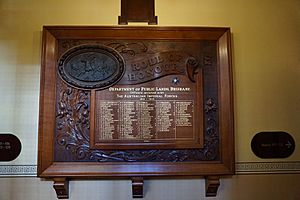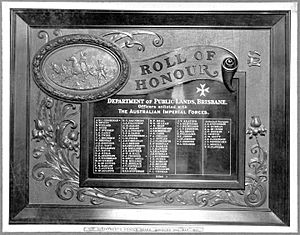First World War Honour Board, Lands Administration Building facts for kids
Quick facts for kids First World War Honour Board, Lands Administration Building |
|
|---|---|

First World War Honour Board
|
|
| Location | Lands Administration Building, 142 George Street, Brisbane City, City of Brisbane, Queensland, Australia |
| Design period | 1914 - 1919 (World War I) |
| Built | 1917 |
| Architect | Alexander Robertson McKellar |
| Official name: First World War Honour Board | |
| Type | state heritage (built) |
| Designated | 21 October 1992 |
| Reference no. | 600117 |
| Significant period | 1917 (fabric) 1917- (historical, social) |
| Significant components | memorial - honour board/ roll of honour |
| Builders | George Varley Boyce |
| Lua error in Module:Location_map at line 420: attempt to index field 'wikibase' (a nil value). | |
The First World War Honour Board is a special memorial located in the Land Administration Building in Brisbane City, Queensland, Australia. It was built in 1917 to remember the brave people from the Queensland Lands Department who served in the First World War. This beautiful board was designed by Alexander Robertson McKellar and crafted by George Varley Boyce. It is so important that it was added to the Queensland Heritage Register in 1992, which means it is protected as a significant historical site.
Contents
A Look Back: The Board's Story
Why Was It Made?
The First World War Honour Board was put up by the employees of the Queensland Lands Department in 1917. They wanted to create a lasting tribute to their co-workers who went away to fight in the war. It was a way to show respect and remember their sacrifice.
Who Designed and Built It?
The main design for the honour board came from Alexander Robertson McKellar. He was a draftsman, which is someone who draws detailed plans, in the survey section. The metal plaque on the board was designed by Arnold Vivan Thomas.
The actual building of the board was a team effort. It was made at the Queensland Government railway workshops in Ipswich. The amazing wood carving was done by George Varley Boyce. He was a very well-known local wood carver who taught carving in Brisbane from about 1902 to 1916.
Unveiling and Remembrance
The honour board was officially revealed on May 2, 1917. The person who unveiled it was the Governor of Queensland at the time, Sir Hamilton Goold-Adams.
Even today, the board is a very important place for Anzac Day ceremonies. Every year on April 25, people lay wreaths in front of it to remember those who served. The Lands Department made sure the board was restored in 1981, keeping it in good condition for future generations.
What Does It Look Like?
The honour board is located on the first floor of the Land Administration Building in Brisbane. You can find it on the wall of the main corridor, right across from the elevator on George Street.
Size and Materials
This is a very large honour board, measuring about 2 meters (6.5 feet) high and 2.5 meters (8.2 feet) wide. It is made mostly from a beautiful wood called Queensland silky oak. The central part of the board is made from red bean wood.
Names and Symbols
On the central red bean panel, you can see the Queensland coat of arms. Below it are the names of 94 staff members from the department and authorized surveyors. Their names are painted in gold.
Around the central panel, the wood is carved with a special pattern called "stippled." In the lower part of the board, you can see carvings of lotus plants. These plants are an ancient symbol of sleep, which is a quiet way to represent peace and rest. It's quite rare to see lotus plants on war memorials in Queensland.
Special Details
In the top left corner, there is a rich carving of laurel leaves. Inside this, there's an oval-shaped metal plaque. This plaque shows a scene in bas relief, which means the images are slightly raised from the surface. It shows cavalry (soldiers on horseback) charging and infantry (soldiers on foot) advancing in battle. This scene helps to show the different types of fighting units involved in the war. A carved scroll unfolds from the plaque, with the words "Roll of Honour" carved into it. The entire board is set within a simple, strong frame.
Why This Board is Special
The First World War Honour Board is listed on the Queensland Heritage Register because it's very important to Queensland's history and culture.
A Unique Record
This board is a unique way to remember the people from Queensland who took part in and made sacrifices during the First World War. It helps us understand that time in history.
Beautiful Craftsmanship
The board is also special because of how beautifully it was made. It shows amazing craftsmanship and has a unique design compared to other war memorials in Queensland.
George Varley Boyce's Work
It's also important because it's the only known public work by the talented local wood carver, George Varley Boyce. His skill makes this board even more valuable.


